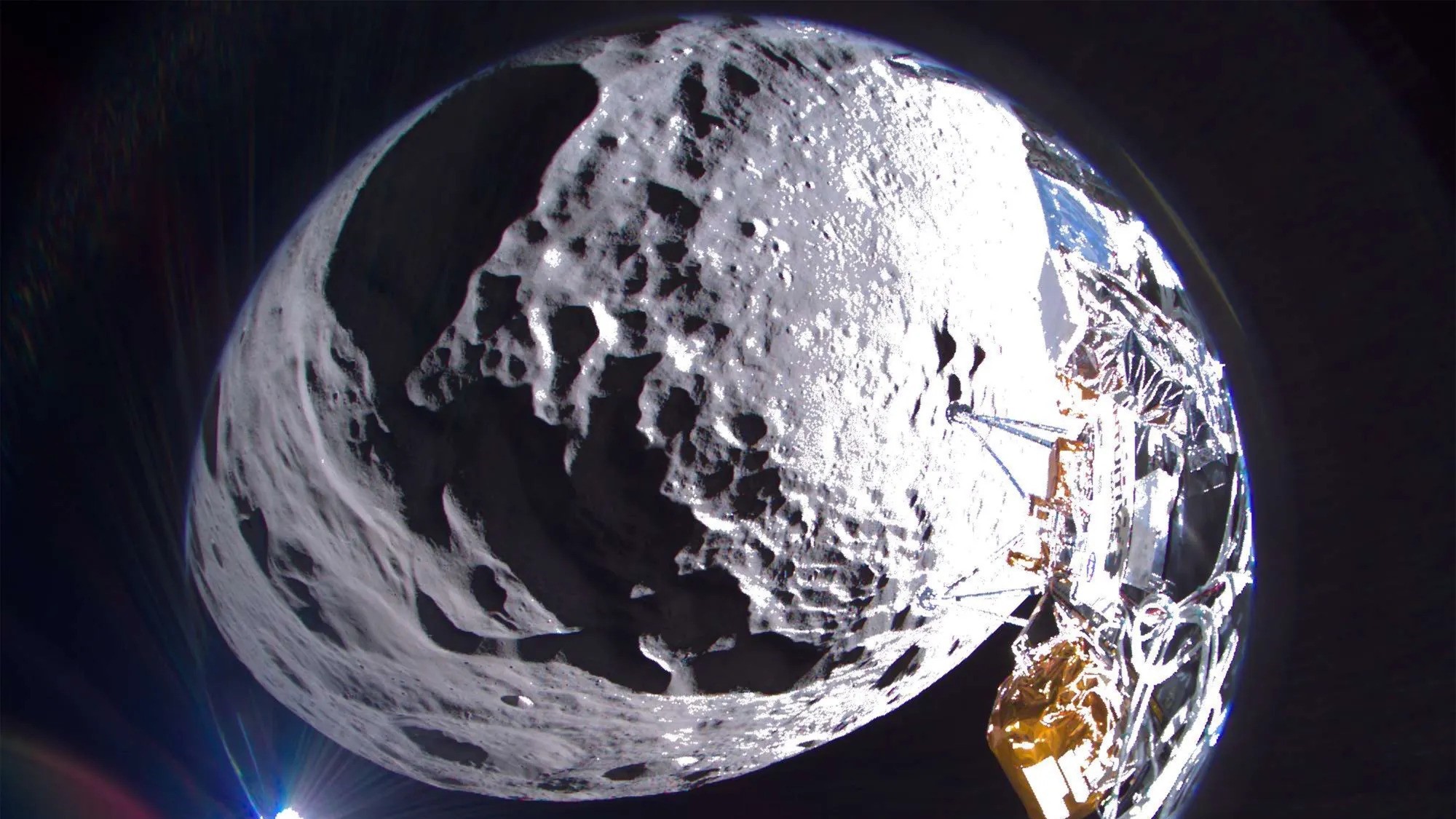1st US spacecraft on moon in 50 years could be dead by Tuesday after face-plant landing
Despite tipping over, Intuitive Machines' Odysseus spacecraft has still completed the key tasks of its mission.

Update: On Monday (Feb. 26) officials with Intuitive Machines said that the Odysseus lander is expected to run out of power and shut down by Tuesday morning, several days short of the week of operations that was previously expected. The lander was not designed to survive lunar night, and may not wake up again after losing power.
The first private spacecraft to ever land on the moon did so with a face-plant, an update from its company reveals.
The Odysseus lander, built by Houston-based company Intuitive Machines, landed at the lunar south pole at 6:23 p.m. EST on Feb. 22, making it the first U.S. lander to park on the moon since Apollo 17 in 1972.
The lander's descent, however, was far from smooth-sailing — after a malfunction with the lasers the spacecraft was using to land, company engineers urgently updated a NASA backup laser that guided it to the moon's surface.
It turns out that despite the quick-fix, the 13-foot-tall (4 meters), six-legged lander "caught a foot in the surface and tipped," Intuitive Machines CEO Steve Altemus said in an update. Yet landing on its side has only partially affected the success of the spacecraft's mission.
"The vehicle is stable, near or at our intended landing site. We do have communications with the lander," Altemus said during a news conference on Sunday (Feb. 25). "If you think back from Apollo days, there wasn't one mission that went absolutely perfectly so you have to be adaptable."
Related: 'Everything has changed since Apollo': Why landing on the moon is still incredibly difficult in 2024
The lander's off-kilter position isn't ideal, but it can still function, with some solar panels pointed at the sun and some of its antennas pointed at ground stations on Earth, Altemas said. But other antennas are less well positioned.
Sign up for the Live Science daily newsletter now
Get the world’s most fascinating discoveries delivered straight to your inbox.
"We do have antennas, however, that are pointed at the [moon's] surface, and those antennas are unusable for transmission back to Earth," he added. "And so, that really is a limiter. Our ability to communicate and get the right data down, so that we get everything we need for the mission, I think, is the most compromised from being on its side."
NASA sent six payloads on board Odysseus, including a set of cameras designed to study how moon dust is displaced by spacecraft landings. Even with the spacecraft tipped, these cameras should be able to collect data until lunar night (the 14 days of darkness when this side of the moon is faced away from the sun), which falls toward the end of the week.
Odysseus launched atop a SpaceX Falcon 9 rocket from NASA's Kennedy Space Center in Cape Canaveral, Florida on Feb. 15 and entered lunar orbit on Feb. 21. It completed one tight loop above the lunar surface before slowing for landing with a few well-timed engine bursts.
The lander arrived close to the Malapert A crater at the lunar south pole. The region has long tantalized scientists with the presence of water ice, which could one day be broken down into hydrogen and oxygen for rocket fuel, according to NASA.
The Odysseus mission is part of NASA's Commercial Lunar Payload Services program, which the space agency established to incentivize the development of private-sector lunar landers. NASA intends to contract these companies to transport cargo and scientific equipment to the moon.
Odysseus's stumble is far from the first recent lunar mishap, and almost certainly the least serious: five of the last nine moon landing attempts ended in failure, including last month's private Peregrine mission, in which the U.S. craft stranded in space and promptly crashed to Earth due an oxidizer leak.
And Japan's SLIM lander made a record-breakingly precise landing on the moon last month, but, just like Odysseus, it also face-planted as it landed. Fortunately, SLIM managed to survive its first freezing lunar night, briefly awakening to snap new photos of the moon before researchers turned it off again to keep its intruments from overheating in the harsh lunar daylight.

Ben Turner is a U.K. based staff writer at Live Science. He covers physics and astronomy, among other topics like tech and climate change. He graduated from University College London with a degree in particle physics before training as a journalist. When he's not writing, Ben enjoys reading literature, playing the guitar and embarrassing himself with chess.









